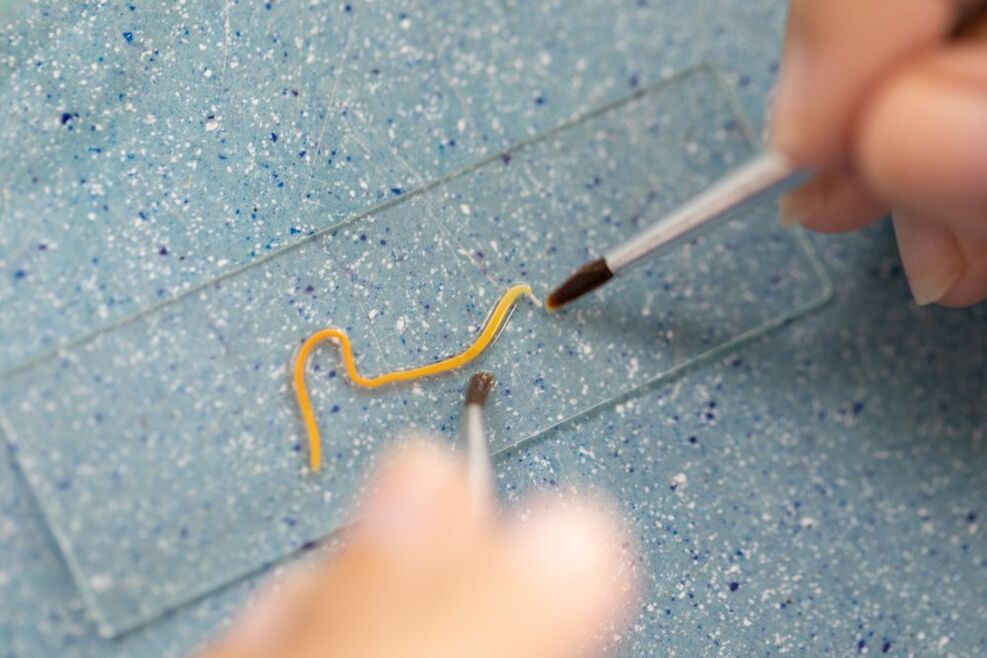Worms are the oldest and numerous inhabitants on our planet. As we all know, they can live almost anywhere, and for many people, the human body is the best environment for survival. There, not only the parasite is protected to the greatest extent from external influences, but it can also receive the nutrients needed for its growth and development. Not all helminthiases have obvious symptoms (such as the same intestinal helminthiasis): usually, a person does not even suspect that uninvited guests are living in his body. How to detect parasite invasion?
Why are worms harmful to humans?

Although worms can survive in the human body for a long time without symptoms, this does not mean that their important activities are safe. All parasites in the process of growth, development and death secrete certain substances that contribute to the development of human sensitivity and allergic reactions. Worms, rashes, itchy skin and even anaphylactic shock.
Similarly, many worms are located in the patient's gastrointestinal tract, disrupting the normal process of digestion and absorption of nutrients. The patient noticed signs of weakness, fatigue, dizziness and dizziness, which may be related to the development of anemia. Iron deficiency, vitamin deficiency and lack of mineral components result in dry nails, hair, skin and brittle mucous membranes. In the context of chronic diarrhea, some patients become dehydrated and even increase the risk of hemorrhoids.
Many worms have mechanical effects on the walls of the gastrointestinal tract. Suction cups and hooks can damage tissues, leading to the formation of ulcerative and erosive changes. It is also known that inflammation of the appendix process occurs in the context of helminthiasis.
Who should be tested?
In fact, everyone is at risk. Almost everyone eats meat or fish, vegetables, fruits and berries, drinks raw water and swims in reservoirs. Children are particularly vulnerable in this regard: they eat worm eggs most often. Young children tend to put dirty toys and any other objects in their mouths, hug stray cats and domestic cats and dogs, and violate personal hygiene rules. There are several types of analysis:
Preventive analysis
Their goal is to detect the parasites in time even when there are no signs. It is recommended that such inspections be carried out at least once a year.
Obstacle analysis
They are designed to prevent the spread of helminthiasis among people. When a child enters a pre-school institution or goes to the swimming pool, a certificate must be provided. Medical and nutrition workers should also undergo similar tests.
According to the indication
If you suspect the occurrence of helminthiasis (epidemiological history and specific symptoms), experts will list a certain range of studies. This allows you to diagnose the disease in time and start treatment.
Analysis of Worm Eggs
The study of feces is a very popular method of detecting worm eggs. In this case, no additional preparation is required: you only need to collect the biological material in a special jar and send it to the laboratory. However, experts recommend not to take any antiparasitic drugs before the test: this may affect its accuracy. It is also worth noting that the analysis must be submitted at least 3 times to exclude false positive and false negative results. Nowadays, the study of worm eggs and feces is gradually being replaced by newer methods-to determine antibodies to certain parasites in the blood.
How to detect small bowel disease?
Intestinal biammiasis is one of the most common helminthiases, and pinworms cause it. This disease is usually found in elementary school and kindergarten children, but adults are also at risk of infection. The main symptom of the disease is severe itching in the perianal area. Diagnosis of bowel disease is made by smearing or scraping from the area near the anus. This is due to the fact that the female of the pathogen leaves the intestine and lays eggs on the surface of the skin folds. This procedure is performed before going to the toilet and washing your hands in the morning, so you can get accurate results.
Diagnosis of asparagus disease

Worms are worms, their body length can reach 40 cm. They can spread throughout the body, not only affecting the gastrointestinal tract, but also the lungs. Specimens of sputum and feces can be used as research materials: genetic material of parasites is found in them. Similarly, a-worm eggs usually appear in the patient's feces. However, the most effective diagnostic method is to detect the antigen-specific antibodies of the parasite in the patient's blood.
How to identify doxorubicin?
The main feature of aspirin disease caused by cat flukes is liver damage. This is why the pod eggs can be found not only in the feces but also in the duodenal juice. In recent years, enzyme immunoassay has been widely used to detect antibodies against doxorubicin. In addition, polymerase chain reaction can be used to detect worms, which is effective even with a small amount of biological materials.
Identification of Trichinosis
Trichinella is a worm that mainly affects muscles, but it can migrate to the central nervous system and cause irreversible changes. If the development of helminthiasis is suspected, muscle biopsy has been performed before, but it has been replaced by serological methods in recent years. Detection of Trichinella antibodies in the patient’s blood is the cause of the diagnosis.

























